How does Mexico celebrate Holy Week? Here are 22 events and practices during Semana Santa in Mexico
This year’s Semana Santa in Mexico takes place from March 24 – 31, 2024. Here are the best events, things to do, and holy week traditions to witness all over the country.
Semana Santa in Mexico is the Holy Week preceding Easter, observed by Christians to commemorate the Passion of Jesus Christ. It begins on Palm Sunday and lasts until Easter Sunday, making it an eight-day celebration filled with various religious and cultural events.
Mexico celebrates Holy Week with a mix of solemn religious observances and vibrant cultural traditions. Events include elaborate passion plays, processions depicting Jesus’ last days, the creation of altars to honor the Virgin Mary’s sorrows, and community gatherings.
The celebrations are marked by a blend of indigenous customs and Spanish colonial heritage, reflecting the country’s rich cultural tapestry.
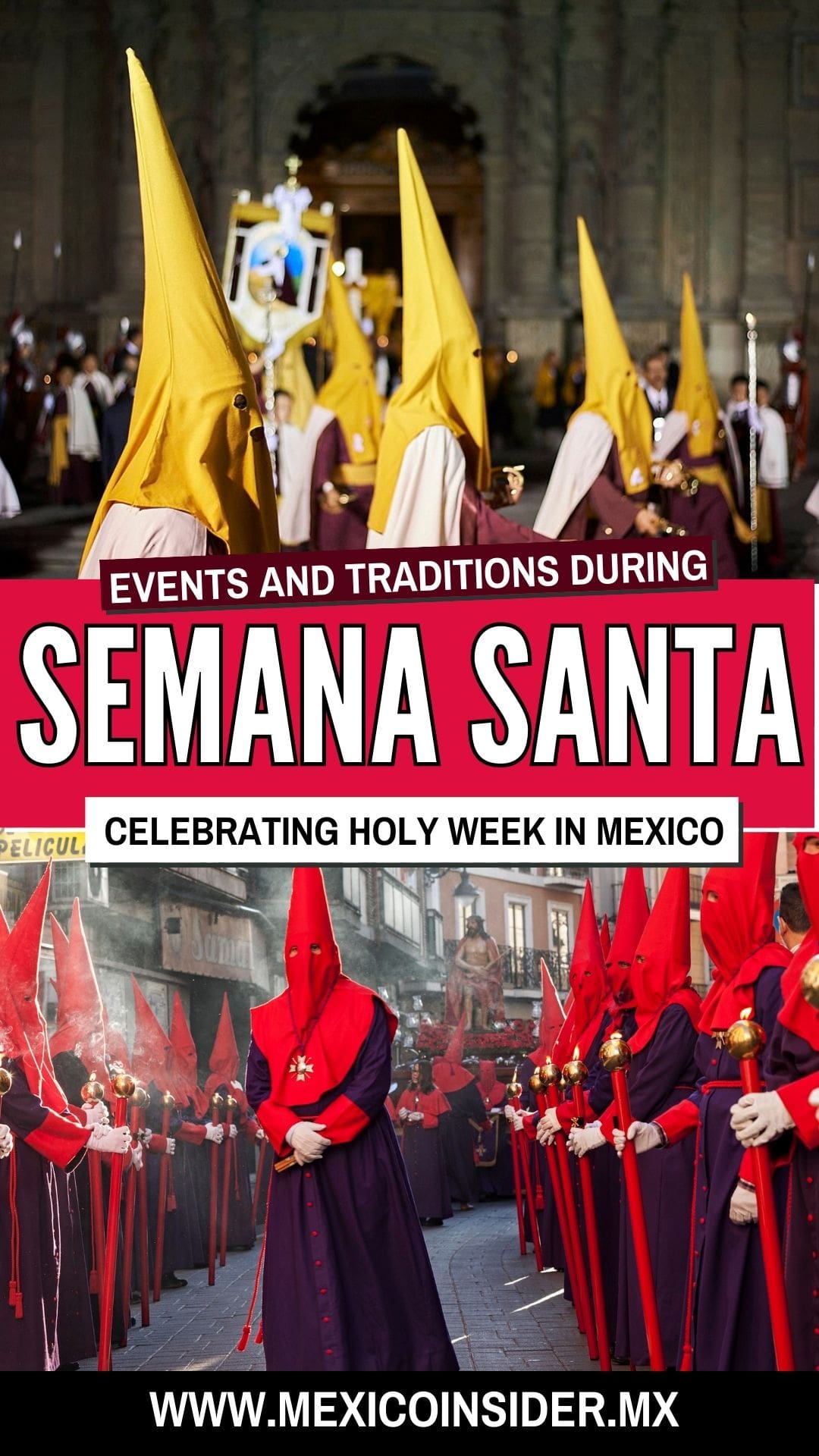
During Semana Santa in Mexico, people participate in processions, attend mass, enact live representations of the Stations of the Cross, and visit churches to pray.
Communities across Mexico also engage in unique local traditions, such as burning Judas effigies or creating sand tapestries. The seven days of Holy Week, which lead up to Easter Sunday, are:
- Palm Sunday (Domingo de Ramos) – Commemorates Jesus Christ’s triumphant entry into Jerusalem.
- Holy Monday (Lunes Santo)
- Holy Tuesday (Martes Santo)
- Holy Wednesday (Miércoles Santo)
- Maundy Thursday (Jueves Santo) – Commemorates the Last Supper of Jesus Christ with the Apostles.
- Good Friday (Viernes Santo) – Observes the crucifixion and death of Jesus.
- Holy Saturday (Sábado Santo) – Marks the day Jesus lay in the tomb.
Easter Sunday (Domingo de Resurrección) celebrates Jesus’s resurrection and follows Holy Saturday, completing the Holy Week observances.
Plan your trip to Mexico with us! Get expert travel advice and customized trip-planning itinerary from our local experts on the ground.
Here are the best events, things to do, and holy week traditions to witness during Semana Santa in Mexico:
1. Palm Sunday (Domingo de Ramos): start of Semana Santa in Mexico
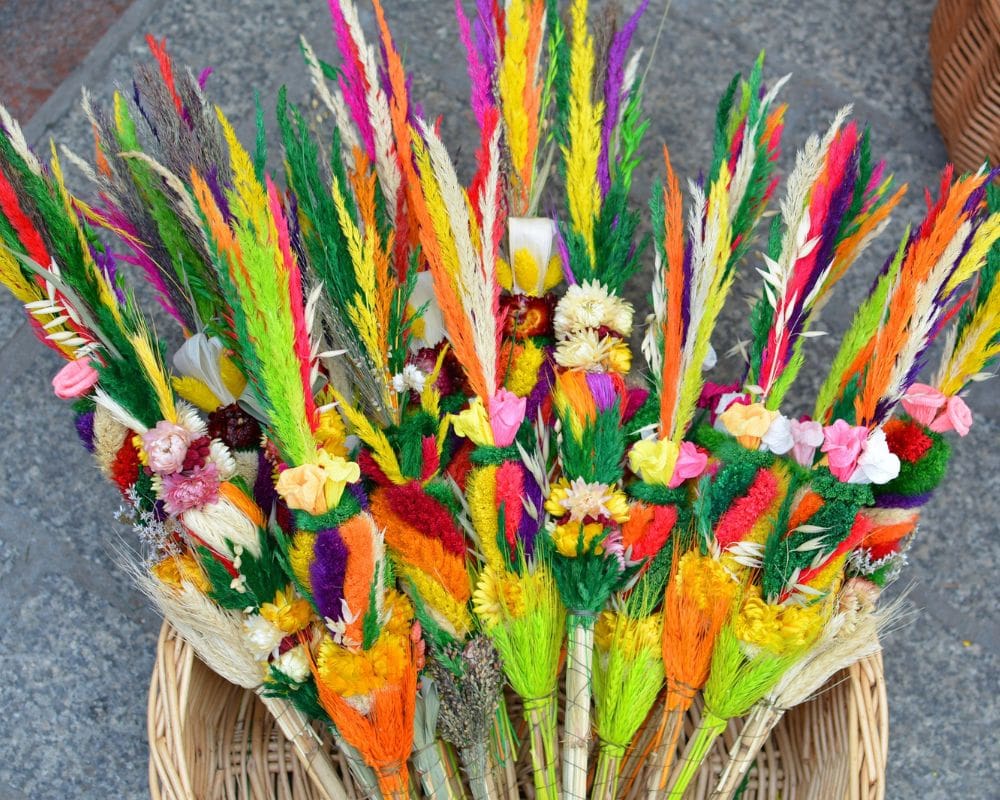
Palm Sunday Procession marks the beginning of Semana Santa in Mexico, celebrating Jesus’ triumphant entry into Jerusalem. This event, steeped in history and tradition, features the faithful carrying elaborately decorated palm fronds.
It’s a practice that has been observed for centuries. It intertwines indigenous customs with Christian rituals and showcases Mexico’s rich cultural tapestry.
During the event, streets across Mexico are lined with vendors selling intricately woven palm fronds, which are then blessed in churches in vibrant ceremonies.
Processions mimic Jesus’ entry, with some including donkeys and participants dressed as biblical figures. This creates a lively, moving tableau that engages spectators and participants alike.
Witnessing the Palm Sunday Processions is a way to immerse oneself in the spiritual and communal essence of Semana Santa in Mexico.
The blend of solemnity and festivity, combined with the artistry of the palm fronds, offers a unique cultural experience. It’s a powerful reminder of faith’s role in public life and personal devotion in Mexico.
For a truly immersive experience, engage with local artisans to learn the art of palm weaving before the procession. Many communities offer workshops in the weeks leading up to Semana Santa.
This supports local craftsmanship and provides a deeper understanding and personal connection to the tradition, enriching your participation in the event.
2. The Silence Procession in San Luis Potosí
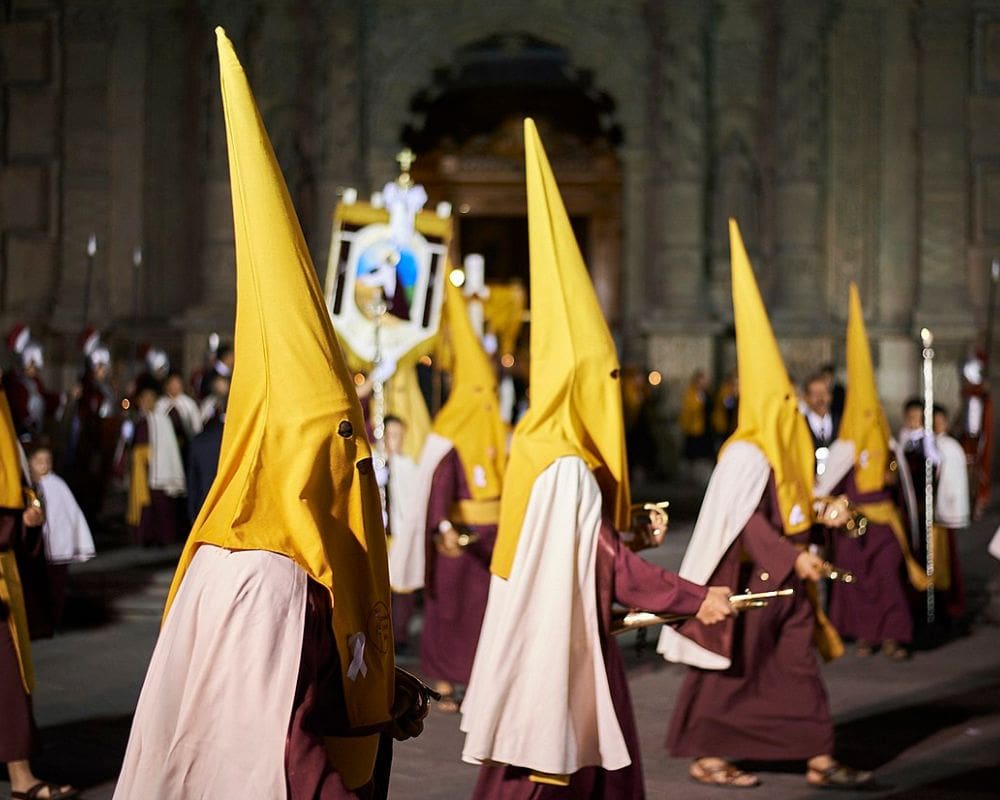
The Silence Procession is a cornerstone of Semana Santa in Mexico, particularly impactful in San Luis Potosi. This nocturnal event on Good Friday symbolizes Jesus’ suffering and death.
Its origins trace back to the Spanish tradition of silent processions, merging local and colonial histories into a solemn observance marked by deep reflection and communal respect.
Dressed in medieval penitential robes and hoods, participants march through the city’s streets in complete silence, carrying religious icons and candles.
The only sounds are the solemn beat of drums and the occasional toll of a bell, creating an atmosphere of reverence and introspection that envelops both participants and onlookers.
The Silence Procession offers an unparalleled experience of collective solemnity and introspection. The profound silence, broken only by the march’s solemn rhythm, invites personal reflection uncommon in today’s noisy world.
Witnessing this event is not just about observing a tradition but participating in a communal act of reverence, making it a deeply moving experience.
Prepare to respect the silence fully by turning off all electronic devices and planning to stay for the duration of the procession. Bring a small, unobtrusive light source, like a penlight, to navigate the event without disrupting its atmosphere.
3. The Burning of Judas in Mexico City
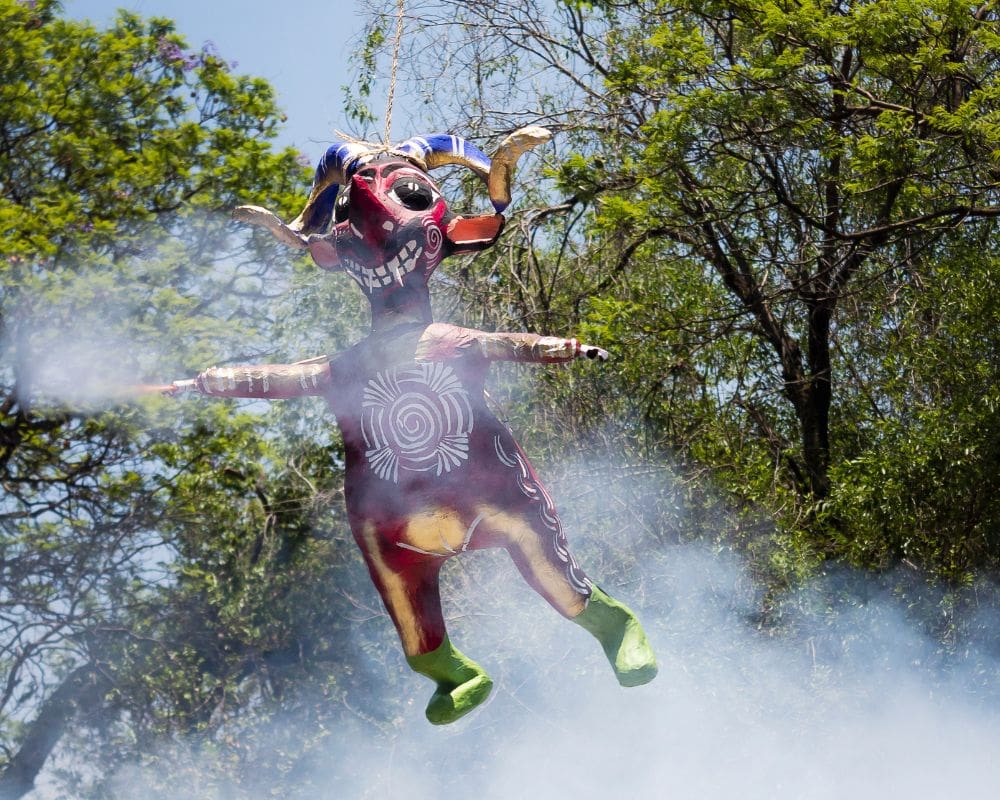
The Burning of Judas is a vibrant and symbolic tradition during Semana Santa in Mexico, particularly prominent in Mexico City.
This event, with roots in European customs, has evolved into a unique Mexican celebration where effigies of Judas Iscariot, often depicted as devils or unpopular figures, are burned to symbolize the triumph of good over evil.
Artisans create and sell colorful, devil-like effigies made of paper-mâché in the days leading up to Holy Saturday.
These figures are then filled with fireworks and publicly burned in an explosive display, accompanied by music, dancing, and revelry, transforming a moment of biblical betrayal into a communal celebration of redemption.
The Burning of Judas is more than a spectacle; it’s a community event that blends humor, artistry, and tradition into a memorable celebration of renewal and justice.
Witnessing this event offers insights into Mexico’s cultural ability to transform historical religious events into vibrant, contemporary festivities that welcome participation and reflection.
Engage directly with the artisans who create the Judas figures in the weeks before Semana Santa. Many are happy to share their techniques and stories, providing a unique insight into this tradition’s significance.
Additionally, consider visiting local workshops or community centers that offer to make your effigy. This hands-on experience will connect you more deeply with this fiery tradition.
4. Passion Plays in Iztapalapa, Mexico City
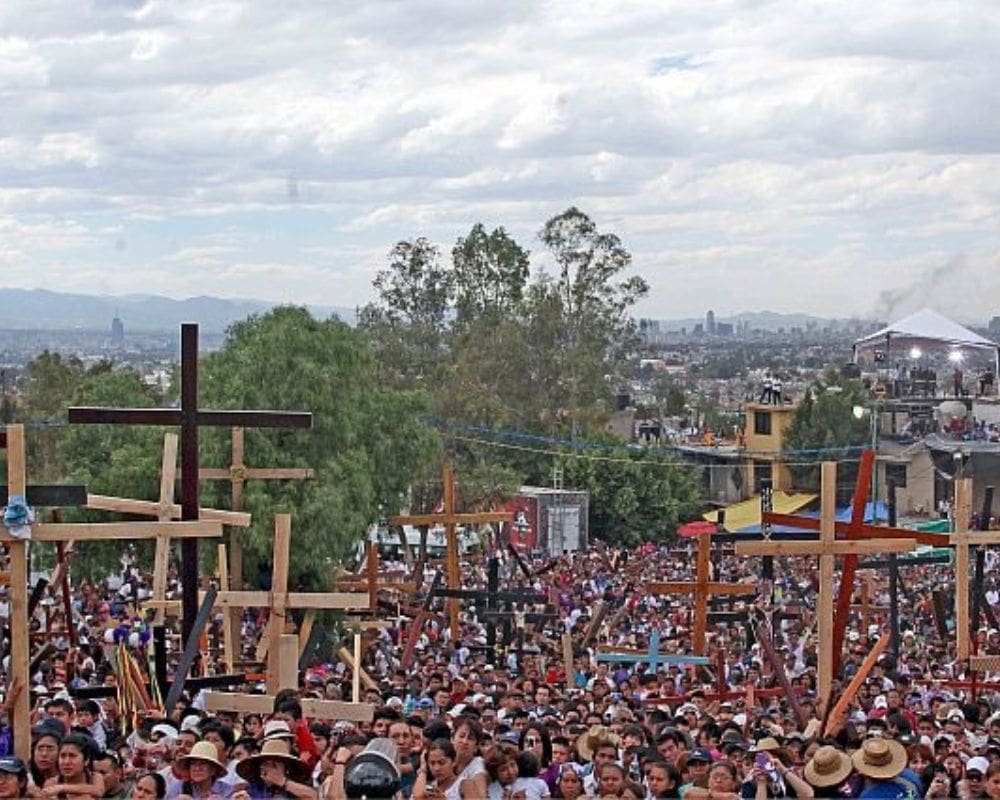
The Passion Plays of Iztapalapa represent the pinnacle of Semana Santa observances in Mexico City, attracting over a million spectators annually.
Following a cholera outbreak, this tradition began in 1833 as a promise to the patron saint for the community’s healing. Today, it stands as one of the world’s largest and most elaborate re-enactments of the Passion of Christ.
During Holy Week, the district of Iztapalapa transforms into a massive stage for the Passion Plays. Hundreds of actors, donned in period costumes, participate in this dramatic portrayal, which culminates in a moving re-enactment of the Crucifixion on Good Friday.
The event spans several days and includes scenes of the Last Supper, Judas’ betrayal, and the Via Crucis (Way of the Cross) procession, drawing deeply on the community’s faith and history.
Experiencing the Passion Plays in Iztapalapa offers a unique blend of devout faith, community spirit, and dramatic storytelling.
The scale and authenticity of the performance, set against the backdrop of Iztapalapa’s streets and hills, provide an immersive experience that’s both educational and spiritually uplifting.
It’s a powerful way to connect with the heart of Semana Santa in Mexico, beyond the veneer of tourism.
To fully embrace this event, consider volunteering with local organizations involved in the preparations. This could include helping with costumes and props or participating in less central roles.
Volunteering offers a behind-the-scenes look at the dedication and community spirit driving this event, fostering a deeper connection and understanding of this profound tradition.
5. Holy Week in Taxco, Guerrero
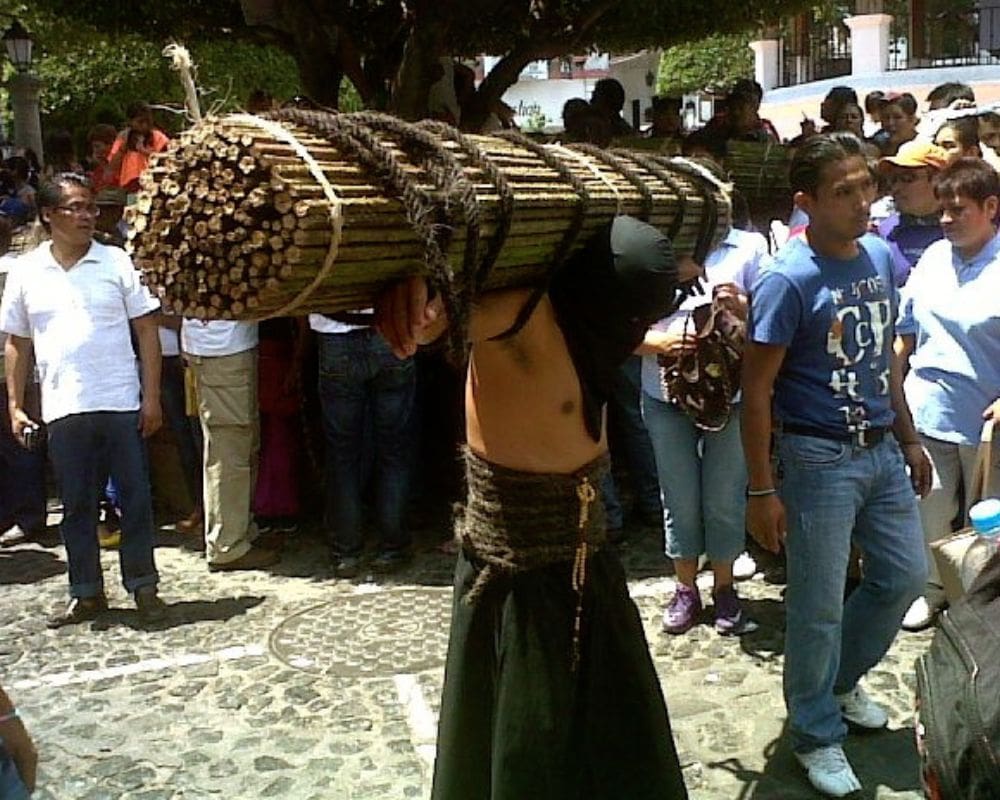
Holy Week in Taxco is one of the most intense and visually stunning celebrations of Semana Santa in Mexico. Known for its steep cobblestone streets and beautiful baroque architecture, Taxco’s observances are deeply rooted in Spanish colonial history and indigenous traditions, creating a unique blend of solemnity and spectacle.
Throughout Holy Week, Taxco witnesses a series of processions, the most notable being the silent, candlelit marches on Maundy Thursday and Good Friday.
Participants, known as “nazarenos,” carry heavy chains and burdens as penance, wearing thorn crowns and bearing large crosses, in a profound display of faith and penitence.
Taxco’s Holy Week is a testament to its participants’ physical and spiritual endurance, set against the dramatic beauty of the town.
The stark contrast of the silent, torch-lit processions against the colonial architecture offers a deeply moving and aesthetically captivating experience. It’s a vivid reminder of the enduring power of faith and tradition in shaping community identity.
For an authentic experience, stay in one of Taxco’s local homes or guesthouses rather than a hotel. Many families open their doors to visitors during Semana Santa, offering a rare opportunity to experience the event from a local perspective.
Engage with your hosts about the traditions and history of Holy Week in Taxco, and you might even find yourself invited to join a procession or a family meal, adding a deeply personal dimension to your visit.
6. Easter Vigil Masses

Easter Vigil Masses are a profound and integral component of Semana Santa in Mexico, marking the end of Lent and the beginning of Easter.
The vigil is a night filled with symbolism, liturgical richness, and ancient traditions, deeply rooted in the Christian faith. It celebrates the resurrection of Jesus Christ, a cornerstone of Christian belief, with a history that stretches back to the Church’s earliest days.
The Easter Vigil encompasses a series of distinct and solemn rituals, starting after sunset on Holy Saturday. It begins with the blessing of the fire, the lighting of the Paschal candle, and the Exsultet proclamation.
The liturgy includes several readings that recount salvation history, the baptism of new members into the Church, and the Eucharist. Churches are initially darkened, then gradually illuminated, symbolizing the light of Christ entering the world.
Attending an Easter Vigil Mass in Mexico is an immersive experience that connects attendees with the deep roots of Christian faith and the communal spirit of Mexican religious tradition.
The transition from darkness to light, the communal baptism, and the festive atmosphere that follows the solemn service are a powerful testament to renewal and hope, making it a spiritually enriching experience.
7. The Black Christ Procession in San Cristobal de las Casas, Chiapas

The Black Christ Procession is a significant religious event during Semana Santa in San Cristobal de las Casas, Chiapas. Centered around the venerated image of the Black Christ of Esquipulas, this tradition is deeply embedded in the region’s cultural and spiritual life.
The statue, known for its miraculous powers, was brought to San Cristobal in the 16th century and became a focal point of devotion and pilgrimage.
On Good Friday, the Black Christ is ceremoniously paraded through the streets of San Cristobal de las Casas, adorned with flowers and surrounded by thousands of devotees.
The procession is marked by a profound sense of reverence and communal participation, with prayers, hymns, and incense creating a solemn atmosphere. This event is a confluence of indigenous and Spanish traditions, reflecting the rich cultural tapestry of Chiapas.
The Black Christ Procession is a unique blend of faith, history, and culture, offering a glimpse into Chiapas’s deep spiritual roots and communal bonds.
The event is not just a religious ceremony but a living tradition that embodies the people’s identity and faith. Witnessing the procession, with its vibrant expressions of devotion and the stunning backdrop of San Cristobal, is a deeply moving experience.
8. Holy Thursday Visits to the Seven Houses
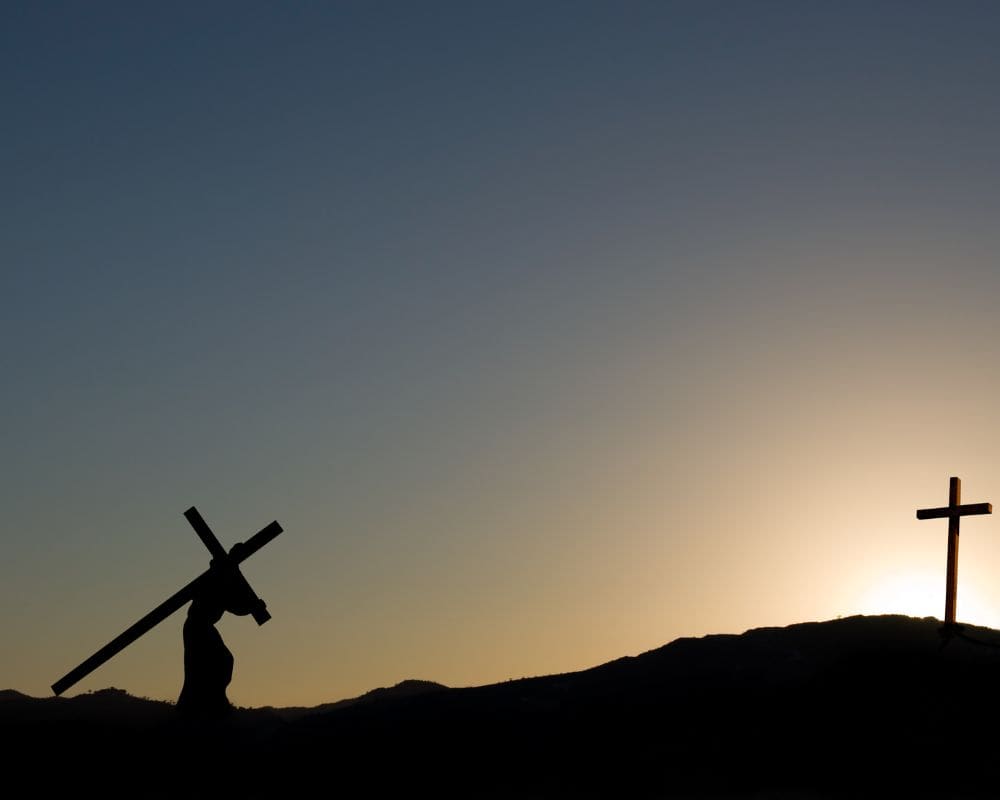
Holy Thursday Visits to the Seven Houses is a devotional tradition observed during Semana Santa in Mexico, symbolizing Jesus’ journey on the night before his crucifixion.
This practice, with roots in medieval Christian rituals, involves visiting seven churches to pray before the Blessed Sacrament, commemorating the stops Jesus made on the way to his crucifixion.
Participants embark on a pilgrimage through the city, visiting seven churches to offer prayers and reflect on the Passion of Christ. At each stop, devotees contemplate and pray, making the Stations of the Cross and meditating on Jesus’ sacrifice. The atmosphere is one of solemnity and introspection, with churches often beautifully decorated for the occasion.
This tradition offers a unique way to engage with the spiritual and communal aspects of Semana Santa in Mexico. It fosters a sense of pilgrimage and reflection, encouraging participants to contemplate the deeper meanings of Easter.
Witnessing the devotion and communal spirit of the participants, set against the backdrop of Mexico’s historic churches, provides a profound insight into the country’s religious culture.
Plan your route in advance and include a mix of well-known cathedrals and smaller, local churches to experience a broader spectrum of community observances.
Engaging local parishioners to hear their stories and insights can enrich the experience. Additionally, consider walking between the churches if distances allow, as this can emulate the pilgrim’s journey, offering a more authentic and reflective experience.
9. The Sea Procession in Puerto Vallarta
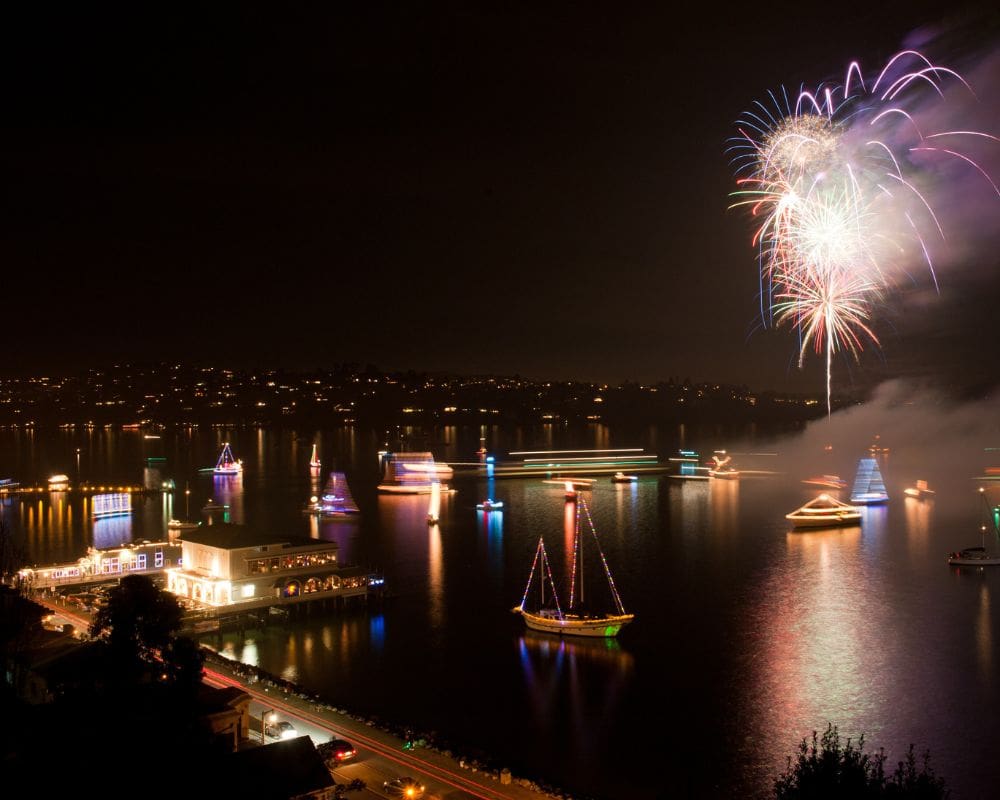
The Sea Procession in Puerto Vallarta is a distinctive celebration during Semana Santa in Mexico, combining the country’s deep Catholic traditions with its rich maritime culture.
This event pays homage to the Virgin of Sorrows (Virgen de los Dolores), a tradition that reflects the community’s connection to the sea and their faith.
It originated as a way for fishermen and sailors to participate in Holy Week, seeking protection and blessings for their endeavors.
A revered image of the Virgin is placed on a decorated boat, leading a flotilla of vessels adorned with flowers and lights. As the procession moves along the coast and into the Bay of Banderas, prayers and hymns fill the air, creating a moving spectacle of faith and tradition.
Onlookers gather along the shore and on other boats to join in the prayers, sing hymns, and witness the solemn yet beautiful ceremony.
Experiencing the Sea Procession in Puerto Vallarta offers a unique perspective on Semana Santa celebrations, blending the solemnity of religious observance with the natural beauty of Mexico’s coastline.
If you’re interested in participating more directly, consider arranging in advance to join one of the boats in the procession. This often requires connecting with local parish groups or fishing communities involved in the organization of the event.
Being on the water with the procession provides an intimate view of this unique tradition, allowing for personal participation in the prayers and songs.
10. Rattles Instead of Bells

The use of rattles instead of bells during Semana Santa in Mexico is a distinctive practice observed from Holy Thursday until the Easter Vigil. This tradition dates back to the Middle Ages in Europe when Spanish missionaries brought it to Mexico.
The silencing of church bells, which are traditionally associated with joy and celebration, symbolizes mourning for Jesus’ death. In their place, wooden rattles (matracas) and other noise-makers are used to call the faithful to services and mark significant moments in the Holy Week liturgies.
Throughout this period, the unique sound of rattles fills the air in churches and communities, serving as a stark auditory reminder of the solemnity of these days.
Volunteers and altar servers use the rattles to announce the start of services, especially the Good Friday liturgy and the Stations of the Cross. The absence of bells and the distinctive rattling sound create a reflective atmosphere, encouraging introspection and remembrance of the Passion of Christ.
The substitution of bells with rattles during Semana Santa vividly expresses the cultural richness and depth of Mexican religious tradition. It offers a unique sensory experience that underscores the solemnity and significance of the Holy Week observances.
This practice connects participants to centuries-old traditions and deepens the communal experience of mourning and reflection, making it a poignant part of Semana Santa celebrations.
11. The Stations of the Cross (Nationwide)
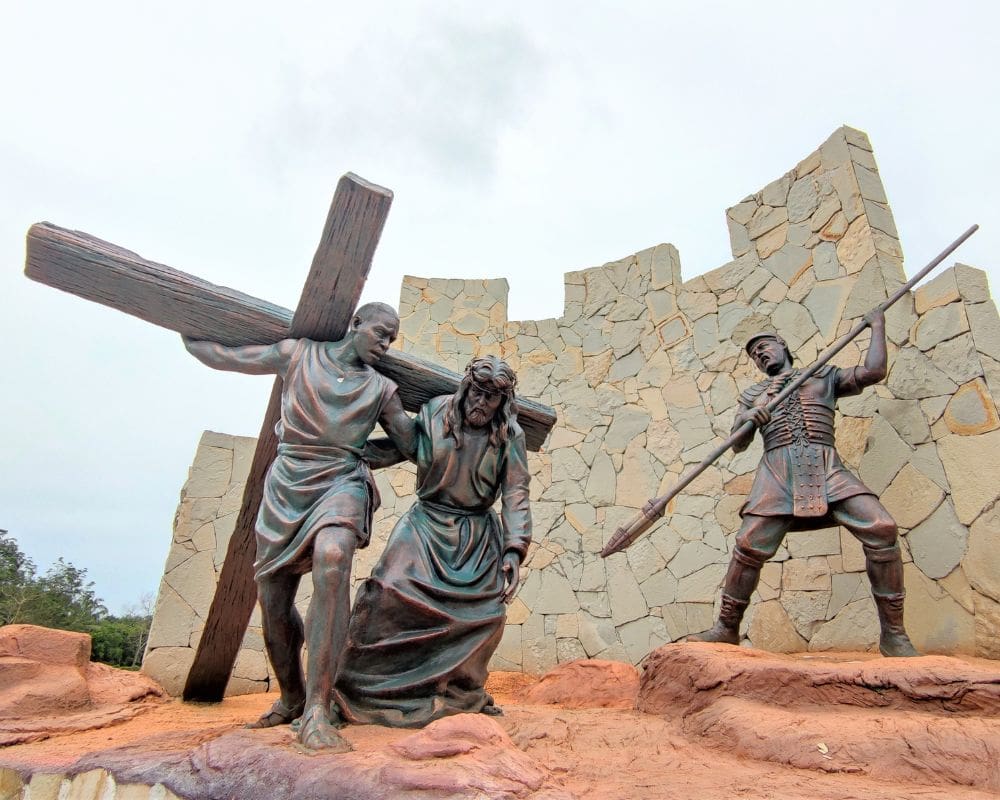
The Stations of the Cross are a deeply spiritual event that forms an integral part of Semana Santa in Mexico. They reflect on Jesus Christ’s journey to Calvary.
This tradition, dating back to the late Middle Ages, involves 14 stations depicting the events of Jesus’ Passion and crucifixion. It’s observed with great reverence across the country, showcasing the nation’s rich Catholic heritage and devotion.
Devotees gather in churches, public squares, and along streets where the Stations of the Cross are enacted or recited. Participants follow the path, praying and meditating at each station, which statues, images, or live re-enactments may represent.
This solemn procession symbolizes a communal pilgrimage, allowing participants to walk with Jesus through his suffering and death spiritually.
Witnessing the Stations of the Cross during Semana Santa in Mexico offers a powerful insight into the country’s religious fervor and the communal aspect of faith.
For a more immersive experience, join a local parish’s preparations for the Stations of the Cross. Many communities create elaborate sets or costumes for live re-enactments and welcome volunteers.
12. Patzcuaro Holy Week in Michoacan

Pátzcuaro’s Holy Week is a vivid and deeply cultural expression of Semana Santa in Mexico, particularly noted for its Indigenous Purépecha influences.
The ceremonies and rituals observed here blend pre-Hispanic traditions with Catholic practices, creating a unique spiritual and cultural experience.
This event draws visitors from around the country and the world, captivated by its authenticity and the serene beauty of Lake Pátzcuaro.
The week is filled with processions, vigils, and rituals that reflect the syncretism of local customs and the Catholic faith. Notable are the silent processions, the dramatic representation of the Last Supper, and the “Procesión de los Cristos,” where sacred images are paraded through the streets.
The local communities around Lake Pátzcuaro participate in these events, each adding their distinctive touch, making it a collective expression of faith and tradition.
The solemnity of the rituals, set against the backdrop of Pátzcuaro’s historic architecture and the region’s natural beauty, offers a deeply moving and aesthetically pleasing experience.
13. Artisan Market of Uruapan in Michoacan
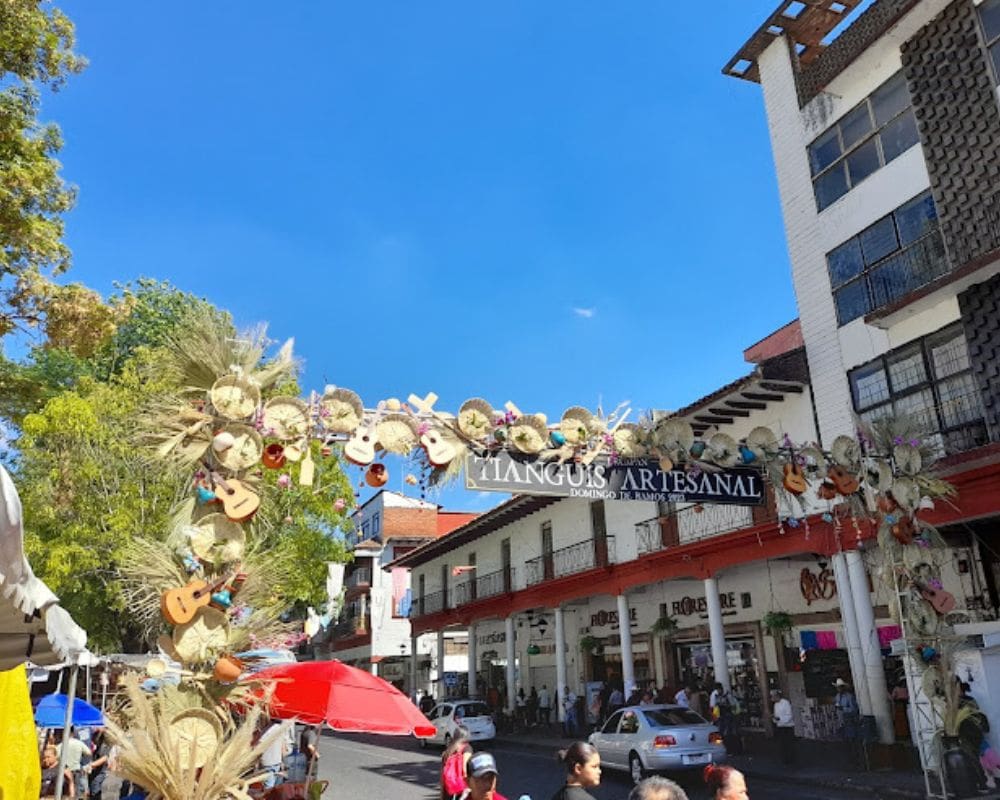
The Artisan Market of Uruapan coincides with Semana Santa in Mexico, showcasing one of the country’s most extensive gatherings of artisans and craftspeople.
This event is both a celebration of Michoacán’s rich cultural heritage and a vital platform for local artisans to display their work, including textiles, pottery, and lacquerware.
It attracts visitors from across Mexico and abroad, eager to explore the diversity and richness of traditional Mexican crafts.
The market transforms Uruapan into a vibrant color, texture, and creativity showcase. Artisans from Michoacán and other regions display their finest works, offering a rare opportunity to see a wide array of traditional Mexican crafts in one place.
Workshops, demonstrations, and cultural performances accompany the market, providing insights into the craftsmanship and traditions behind the art.
Visiting the Artisan Market of Uruapan during Semana Santa is an unparalleled opportunity to experience the depth of Mexico’s artistic traditions firsthand. It’s not just a market; it’s a celebration of cultural identity, craftsmanship, and community.
Consider attending a workshop or demonstration, often held in conjunction with the market, to gain hands-on experience with a traditional craft, such as pottery making or textile weaving.
14. Ceremony of the Encounter in Oaxaca

The Ceremony of the Encounter is a poignant event during Semana Santa in Oaxaca that dramatizes the meeting of the Virgin Mary and Jesus Christ on the way to Calvary.
This tradition, rich in history and emotion, showcases Oaxaca’s deep religious fervor and vibrant cultural tapestry. It encapsulates the blend of Indigenous and Spanish influences that characterize the region’s unique expression of faith.
On Good Friday, two processions—one representing the Virgin Mary and the other Jesus Christ—wind through the streets of Oaxaca, culminating in a dramatic encounter.
This moment is marked by prayers, music, and often, a heartfelt sermon that reflects on the themes of suffering, loss, and ultimately, redemption. The elaborate costumes, heartfelt performances by community members, and the emotional intensity of the encounter make it a deeply moving event.
Witnessing the Ceremony of the Encounter in Oaxaca during Semana Santa offers a unique insight into the communal and performative aspects of faith in Mexico.
It’s a powerful demonstration of the storytelling at the heart of religious observance, steeped in local traditions and history. This event not only provides a window into the spiritual life of Oaxaca but also invites reflection on universal themes of love, sacrifice, and hope.
15. Palm Market in Cholula, Puebla
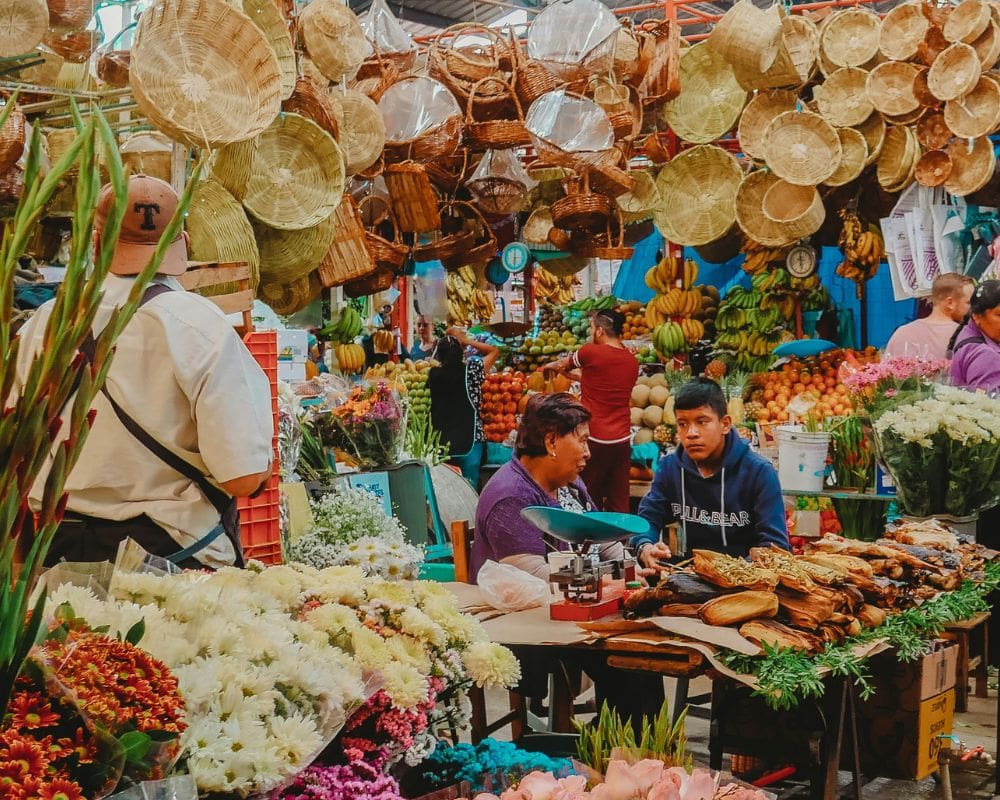
The Palm Market in Cholula is an annual event that precedes Semana Santa in Mexico. It focuses on the tradition of blessing palm fronds on Palm Sunday.
This market is a place to purchase beautifully crafted palm creations and celebrate the craftsmanship and religious devotion that characterize the Holy Week observances.
Artisans from Puebla and surrounding areas gather to sell their intricately woven palm fronds, often adorned with flowers and religious motifs.
The market fills with a variety of palm fronds, ranging from simple designs to elaborate sculptures several feet high. Artisans demonstrate their weaving techniques, creating intricate patterns and figures before your eyes.
The atmosphere is festive, with local foods and music, but the focus remains on the palms and their significance in the upcoming Holy Week celebrations. Purchasers of these palms will bring them to church on Palm Sunday to be blessed, merging tradition with personal devotion.
Attending the Palm Market in Cholula offers a colorful insight into the preparations for Semana Santa in Mexico. It’s an opportunity to appreciate the artistry of palm weaving, a craft passed down through generations.
The market is a testament to the living traditions of Mexican Catholicism, blending artistic expression with spiritual observance. For visitors, it’s a chance to participate in a local tradition, adding depth to their understanding of Holy Week in Mexico.
16. The Descent of the Lord of the Column in Bernal, Querétaro

The Descent of the Lord of the Column is a deeply revered event marking the beginning of Semana Santa in Bernal, Querétaro. It centers around a cherished statue of Christ, believed to possess miraculous powers.
This tradition, with roots in the early 19th century, symbolizes Jesus’ anguish before his crucifixion. The event draws thousands of pilgrims and visitors to the small town of Bernal, located at the foot of the third-largest monolith in the world.
In the early hours before dawn, pilgrims and local residents participate in a solemn procession, carrying the statue of the Lord of the Column from the chapel to the main church.
The air is filled with chants and prayers, creating an atmosphere of devotion and reflection. Candles and torches illuminate the procession, adding to the mystical ambiance of the event.
Experiencing the Descent of the Lord of the Column offers a unique insight into the spiritual intensity and community cohesion that characterizes Semana Santa in Mexico.
The blend of indigenous and Christian traditions against the dramatic backdrop of the Bernal monolith provides a powerful setting for reflection on faith and renewal. It’s a moment of profound spiritual connection shared by the community and visitors alike.
17. Procession of the Virgins in Tzintzuntzan, Michoacán
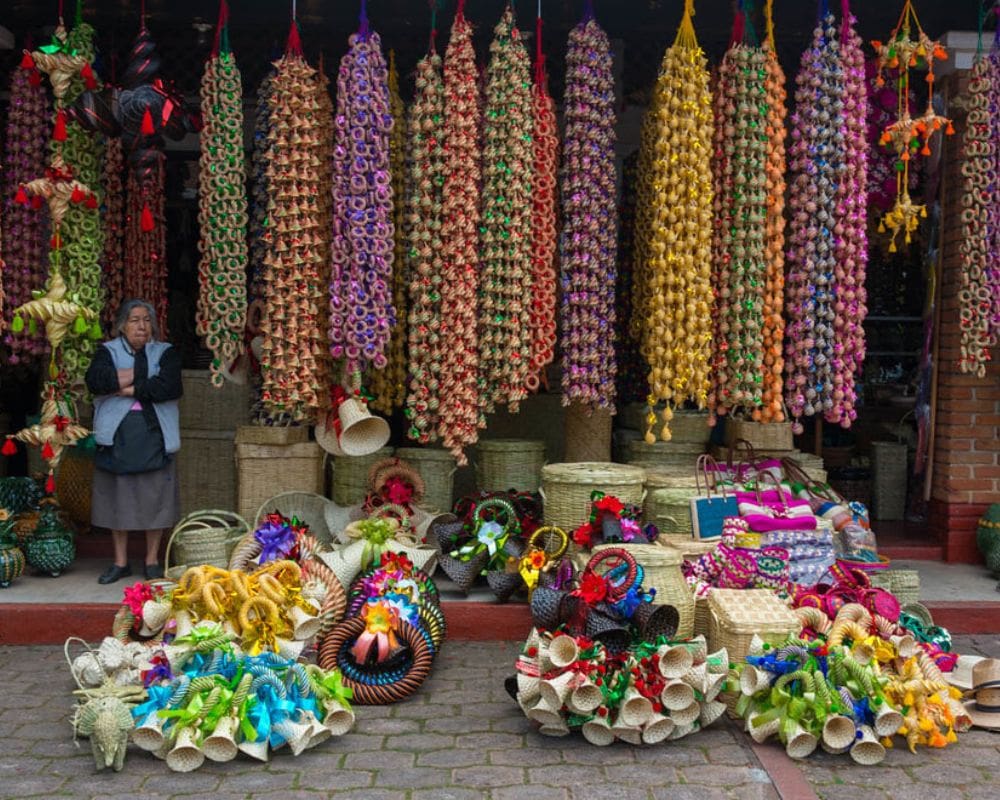
The Procession of the Virgins is a visually stunning event during Semana Santa in Tzintzuntzan, Michoacán, showcasing the region’s deep devotion and rich cultural heritage.
This procession features statues of the Virgin Mary from various communities, each adorned in elaborate garments reflecting indigenous craftsmanship and Spanish colonial influence.
Tzintzuntzan, an ancient Purépecha capital, becomes a focal point for cultural and spiritual celebration, attracting visitors keen to witness this unique melding of traditions.
On Holy Saturday, the quiet streets of Tzintzuntzan come alive as the statues of the Virgin Mary, each representing different localities, are paraded through the town.
Accompanied by music, prayers, and sometimes indigenous dances, the procession highlights the community’s veneration of Mary and its unity in faith. The colorful attire of the participants and the floral decorations add to the procession’s beauty, creating a captivating spectacle.
The Procession of the Virgins in Tzintzuntzan offers a rare glimpse into the syncretic religious practices that define Semana Santa in Mexico. It’s an opportunity to experience a living tradition that embodies the resilience and adaptability of indigenous cultures, merged seamlessly with Christian beliefs.
The event is not just a procession; it’s a vibrant celebration of faith, identity, and community, set against the backdrop of Michoacán’s stunning landscapes and historical sites.
18. The Washing of the Feet in Churches (Nationwide)

The Washing of the Feet is a poignant ceremony observed in Catholic churches across Mexico during Semana Santa, commemorating Jesus’ act of humility and service towards his disciples at the Last Supper.
This ritual, taking place on Holy Thursday, emphasizes love, humility, and the call to service that are central to Christian teaching. It is a deeply moving and symbolic event that engages communities in a shared reflection on the values of service and compassion.
During the ceremony, priests replicate Jesus’ gesture by washing the feet of selected parishioners, symbolizing the breaking down of social barriers and the call to serve one another.
This act is accompanied by prayers, hymns, and readings from the scriptures, highlighting its spiritual significance. The congregation participates actively, reflecting on the lessons of humility and service embodied in the ritual.
19. Solemn Mass of the Lord’s Supper

The Solemn Mass of the Lord’s Supper is a central liturgical service during Semana Santa in Mexico. It commemorates Jesus Christ’s Last Supper with his disciples.
This Mass marks the initiation of the Easter Triduum – the three most sacred days in the Christian liturgical calendar. It celebrates the institution of the Eucharist and the establishment of the priesthood, making it a profound expression of faith and community.
Held on Holy Thursday evening, the Mass features the ceremonial washing of feet, echoing Jesus’ act of service. It also includes the procession of the Holy Eucharist to the Altar of Repose, where it remains ‘entombed’ until the Easter Vigil, symbolizing Jesus’ death and burial.
The church is filled with the faithful, who participate in the prayers, readings, and hymns recounting the Last Supper’s events and significance.
For a truly immersive experience, participate in the tradition of visiting the Altar of Repose after the Mass. Many devotees undertake a pilgrimage, visiting several churches to pray before the Eucharist in repose and reflect on Jesus’ agony in the garden.
20. Good Friday Procession in Cuetzalan, Puebla

The Good Friday Procession in Cuetzalan, Puebla, is a visually striking and emotionally charged event during Semana Santa in Mexico.
This indigenous Nahua community combines pre-Hispanic traditions with Christian rituals to commemorate Jesus Christ’s Passion and death uniquely.
The procession is characterized by its solemnity, the deep involvement of the community, and the blending of local customs, making it a distinct expression of faith and cultural identity.
Participants, dressed in traditional Nahua attire, carry religious icons and statues through the cobbled streets of Cuetzalan. The procession includes representations of the Stations of the Cross, with tableaux vivants (living pictures) that dramatically portray the events of Jesus’ crucifixion.
The Good Friday Procession in Cuetzalan offers a unique opportunity to experience Semana Santa in a context where indigenous culture and Christian faith intertwine.
The event not only provides insight into the religious practices of the Nahua people but also showcases the profound sense of community and spirituality that pervades this historic town.
21. Altares de Dolores

Altares de Dolores is a poignant tradition observed on the Friday before Palm Sunday, marking the beginning of Semana Santa in Mexico. This custom involves setting up altars dedicated to the Virgin Mary’s sorrows, reflecting on her suffering as the mother of Jesus.
The tradition, deeply rooted in Mexican Catholicism, blends indigenous and Spanish influences, showcasing Mexico’s rich cultural and religious tapestry.
Families, churches, and communities create elaborate altars adorned with statues or images of the Virgin Mary, surrounded by offerings of candles, flowers, and symbols of her seven sorrows.
These altars are often open to the public, inviting visitors to reflect and pray. The ambiance is one of solemn reverence, highlighted by the singing of hymns and the recitation of prayers dedicated to the Virgin’s sorrows.
Experiencing Altares de Dolores provides a unique insight into the depth of Marian devotion in Semana Santa celebrations across Mexico.
It’s an opportunity to engage with a tradition that exemplifies the blend of faith, art, and community inherent in Mexican religious practices. The beauty and solemnity of the altars, coupled with the communal spirit of the observance, offer a moving and contemplative start to Holy Week.
22. Semana Santa in Valladolid, Yucatán
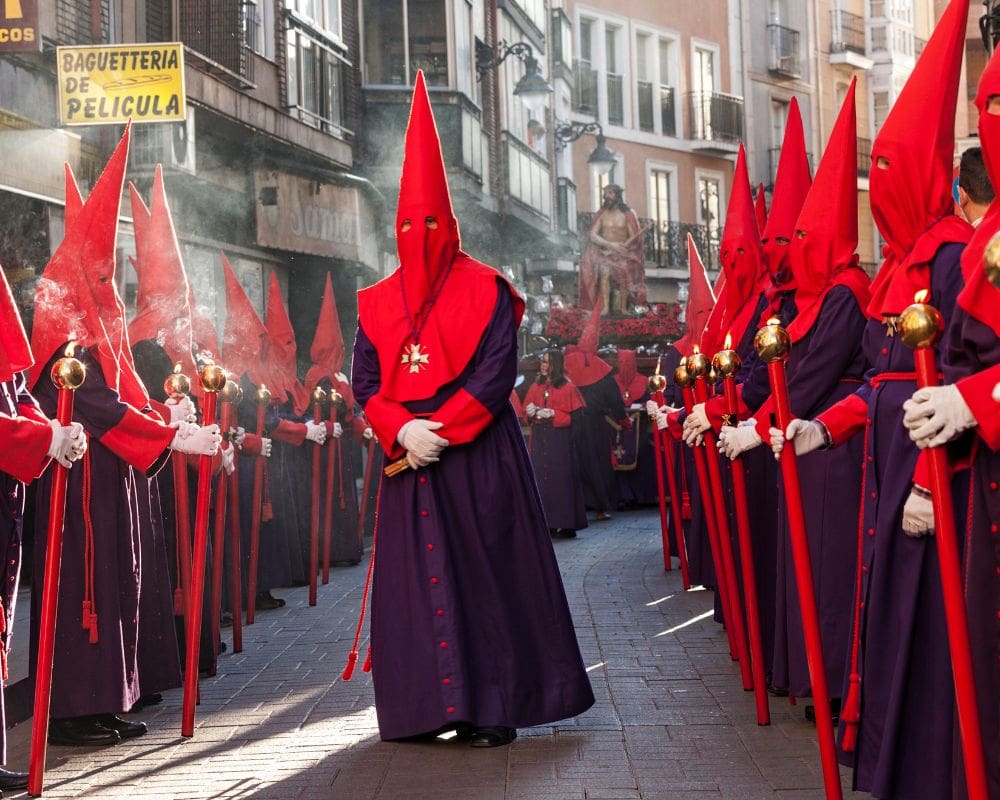
Semana Santa in Valladolid, Yucatan, is a vibrant and deeply spiritual celebration, reflecting the unique blend of Mayan and Spanish colonial influences that characterize the region.
This week-long observance includes a series of processions, masses, and rituals that draw both locals and visitors into a profound communal reflection on the Passion of Christ.
Valladolid’s rich historical backdrop adds layers of meaning to the celebrations, making it a distinct experience within Mexico’s Holy Week observances.
The city’s streets and churches become stages for the dramatic re-enactments of biblical events, from Jesus’ entry into Jerusalem to his resurrection.
Traditional dances, Mayan rituals, and Christian ceremonies intermingle, highlighting the cultural syncretism of the Yucatán. Key events include the Procession of Silence, the re-enactment of the Via Crucis, and the joyous Easter Sunday celebrations, each marked by deep devotion and community participation.
Witnessing Semana Santa in Valladolid offers an immersive journey into the heart of Yucatán’s cultural and religious heritage. The unique integration of Mayan traditions with Christian rituals provides a distinct perspective on Holy Week, emphasizing the universality of spiritual themes across cultures.
The warmth of the local community, combined with the historic beauty of Valladolid, creates a captivating setting for experiencing the solemnity and celebration of Semana Santa.

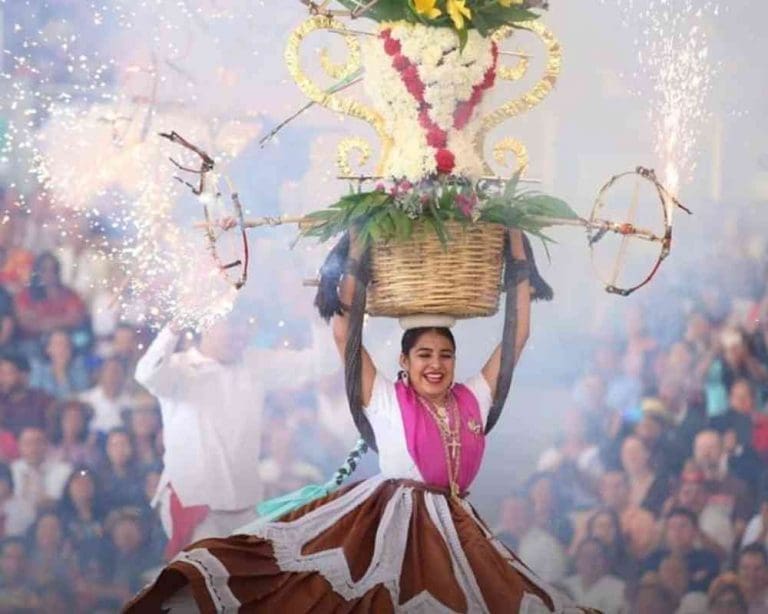
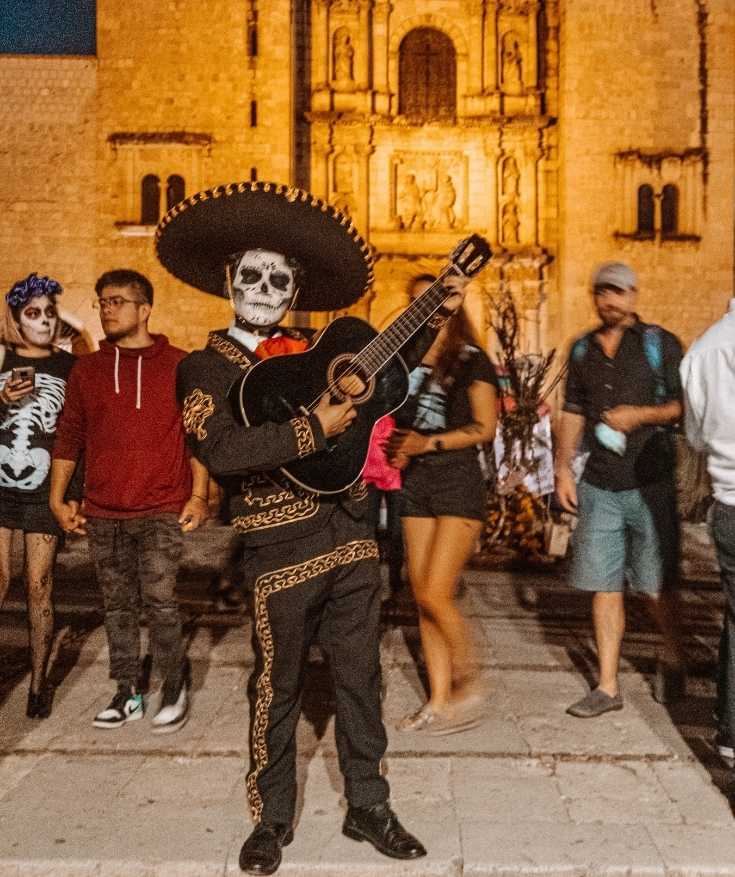



![The 32 Mexico states, explained [with free map!]](https://b2853340.smushcdn.com/2853340/wp-content/uploads/2023/01/Mexico-States-Mexico-Map-768x614.jpg?lossy=2&strip=1&webp=1)